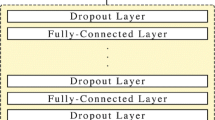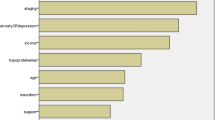Abstract
Cushing's disease (CD) is a rare disease that occurs in 1.2–1.4 persons per million population per year. Recurrence prediction after transsphenoidal surgery (TSS) is important for determining individual treatment and follow-up strategies. Between 2000 and 2017, 354 CD patients with initial postoperative remission and long-term follow-up data were enrolled from Peking union medical college hospital (PUMCH) to predict recurrence, and PUMCH is one of the largest CD treatment centers in the world. We first investigated the effect of a factorization machine (FM)-based neural network to predict recurrence after TSS for CD. This method could automatically reduce a portion of the cross-feature selection work with acceptable parameters. We conducted a performance comparison of various algorithms on the collected dataset. To address the lack of interpretability of neural network models, we also used the local interpretable model-agnostic explanations approach, which provides an explanation in the form of relevant features of the predicted results by approximating the model behavior of the variables in a local manner. Compared with existing methods, the DeepFM model obtained the highest AUC value (0.869) and the lowest log loss value (0.256). According to the importance of each feature, three top features for the DeepFM model were postoperative morning adrenocorticotropic hormone level, age, and postoperative morning serum cortisol nadir. In the post hoc explanation phase, the above-mentioned importance-leading features made a great contribution to the prediction probability. The results showed that deep learning-based models could better aid neurosurgeons in recurrence prediction after TTS for patients with CD, and could contribute to determining individual treatment strategies.



Similar content being viewed by others
Abbreviations
- CD:
-
Cushing’s disease
- UFC:
-
Urine free cortisol
- ACTH:
-
Adrenocorticotropin
- BMI:
-
Body mass index
- PrC:
-
Preoperative morning serum cortisol level
- PrUFC:
-
Preoperative 24 h UFC level
- PrACTH:
-
Preoperative morning ACTH level
- PoACTH:
-
Postoperative morning ACTH level
- PoC:
-
Postoperative morning serum cortisol nadir
- PoUFC:
-
Postoperative 24 h UFC nadir level
- CSI:
-
Cavernous sinus invasion
- MLP:
-
Multilayer perceptron
- LR:
-
Logistic regression
- DT:
-
Decision tree
- RF:
-
Random forest
- GaussianNB:
-
Gaussian Naive Bayes
- GBDT:
-
Gradient tree boosting
- PNN:
-
Product-based neural network
- DeepFM:
-
Factorization-Machine neural network
- LIME:
-
Local interpretable model-agnostic explanations
- TSS:
-
Transsphenoidal surgery
References
Abdelmannan D, Chaiban J, Selman WR, Arafah BM (2013) Recurrences of ACTH-secreting adenomas after pituitary adenomectomy can be accurately predicted by perioperative measurements of plasma ACTH levels. J Clin Endocrinol Metab 98:1458–1465. https://doi.org/10.1210/jc.2012-3910
Alexandraki KI et al (2013) Long-term remission and recurrence rates in Cushing’s disease: predictive factors in a single-centre study. Eur J Endocrinol 168:639–648. https://doi.org/10.1530/EJE-12-0921
Aranda G et al (2015) Long-term remission and recurrence rate in a cohort of Cushing’s disease: the need for long-term follow-up. Pituitary 18:142–149. https://doi.org/10.1007/s11102-014-0567-8
Artusi A, Banterle F, Carrara F, Moreo A (2019) Efficient evaluation of image quality via deep-learning approximation of perceptual metrics. IEEE Trans Image Process. https://doi.org/10.1109/TIP.2019.2944079
Asuzu D et al (2017) Normalized early postoperative cortisol and ACTH values predict nonremission after surgery for Cushing disease. J Clin Endocrinol Metab 102:2179–2187. https://doi.org/10.1210/jc.2016-3908
Bojikian KD, Lee CS, Lee AY (2019) Finding glaucoma in color fundus photographs using deep learning. JAMA Ophthalmol. https://doi.org/10.1001/jamaophthalmol.2019.3512
Chandler WF, Barkan AL, Hollon T, Sakharova A, Sack J, Brahma B, Schteingart DE (2016) Outcome of transsphenoidal surgery for Cushing disease: a single-center experience over 32 years. Neurosurgery 78:216–223. https://doi.org/10.1227/NEU.0000000000001011
Cheerla A, Gevaert O (2019) Deep learning with multimodal representation for pancancer prognosis prediction. Bioinformatics 35:i446–i454. https://doi.org/10.1093/bioinformatics/btz342
Chen R, Yang L, Goodison S, Sun Y (2019) Deep learning approach to identifying cancer subtypes using high-dimensional genomic data. Bioinformatics. https://doi.org/10.1093/bioinformatics/btz769
Cheng H-T et al. (2016) Wide and deep learning for recommender systems. Paper presented at the Proceedings of the 1st Workshop on Deep Learning for Recommender Systems, Boston, MA, USA
Courtiol P et al (2019) Deep learning-based classification of mesothelioma improves prediction of patient outcome. Nat Med. https://doi.org/10.1038/s41591-019-0583-3
Guo H, Tang R, Ye Y, Li Z, He X (2017) DeepFM: a factorization-machine based neural network for CTR prediction. arXiv preprint arXiv:170304247
Ham YG, Kim JH, Luo JJ (2019) Deep learning for multi-year ENSO forecasts. Nature 573:568–572. https://doi.org/10.1038/s41586-019-1559-7
Hofmann BM, Hlavac M, Martinez R, Buchfelder M, Muller OA, Fahlbusch R (2008) Long-term results after microsurgery for Cushing disease: experience with 426 primary operations over 35 years. J Neurosurg 108:9–18. https://doi.org/10.3171/JNS/2008/108/01/0009
Ironside N et al (2018) Earlier post-operative hypocortisolemia may predict durable remission from Cushing’s disease. Eur J Endocrinol 178:255–263. https://doi.org/10.1530/EJE-17-0873
Lambert JK, Goldberg L, Fayngold S, Kostadinov J, Post KD, Geer EB (2013) Predictors of mortality and long-term outcomes in treated Cushing’s disease: a study of 346 patients. J Clin Endocrinol Metab 98:1022–1030. https://doi.org/10.1210/jc.2012-2893
Lindsay JR, Oldfield EH, Stratakis CA, Nieman LK (2011) The postoperative basal cortisol and CRH tests for prediction of long-term remission from Cushing’s disease after transsphenoidal surgery. J Clin Endocrinol Metab 96:2057–2064. https://doi.org/10.1210/jc.2011-0456
Liu Y et al (2019) Prediction of recurrence after transsphenoidal surgery for Cushing’s disease: the use of machine learning algorithms. Neuroendocrinology 108:201–210. https://doi.org/10.1159/000496753
Nieman LK et al (2015) Treatment of Cushing’s syndrome: an endocrine society clinical practice guideline. J Clin Endocrinol Metab 100:2807–2831. https://doi.org/10.1210/jc.2015-1818
Nieman LK, Biller BM, Findling JW, Newell-Price J, Savage MO, Stewart PM, Montori VM (2008) The diagnosis of Cushing’s syndrome: an endocrine society clinical practice guideline. J Clin Endocrinol Metab 93:1526–1540. https://doi.org/10.1210/jc.2008-0125
Nishioka H, Yamada S (2019) Cushing's disease. J Clin Med. https://doi.org/10.3390/jcm8111951
Pendharkar AV, Sussman ES, Ho AL, Hayden Gephart MG, Katznelson L (2015) Cushing’s disease: predicting long-term remission after surgical treatment. Neurosurg Focus 38:E13. https://doi.org/10.3171/2014.10.FOCUS14682
Qu Y, Cai H, Ren K, Zhang W, Yu Y, Wen Y, Wang J (2016) Product-based neural networks for user response prediction. In: 2016 IEEE 16th International Conference on Data Mining (ICDM), 12–15 Dec. 2016. pp 1149–1154. https://doi.org/10.1109/ICDM.2016.0151
Ragnarsson O et al (2019) Overall and disease-specific mortality in patients with Cushing disease: a Swedish nationwide study. J Clin Endocrinol Metab 104:2375–2384. https://doi.org/10.1210/jc.2018-02524
Rendle S (2010) Factorization machines. In: 2010 IEEE International Conference on Data Mining. IEEE, pp 995–1000
Ribeiro MT, Singh S, Guestrin C (2016) "Why should i trust you?": Explaining the predictions of any classifier
Shirvani M, Motiei-Langroudi R, Sadeghian H (2016) Outcome of microscopic transsphenoidal surgery in cushing disease: a case series of 96 patients. World Neurosurg 87:170–175. https://doi.org/10.1016/j.wneu.2015.11.046
Sonino N, Zielezny M, Fava GA, Fallo F, Boscaro M (1996) Risk factors and long-term outcome in pituitary-dependent Cushing’s disease. J Clin Endocrinol Metab 81:2647–2652. https://doi.org/10.1210/jcem.81.7.8675592
Starke RM, Reames DL, Chen CJ, Laws ER, Jane JA Jr (2013) Endoscopic transsphenoidal surgery for cushing disease: techniques, outcomes, and predictors of remission. Neurosurgery 72:240–247. https://doi.org/10.1227/NEU.0b013e31827b966a(discussion 247)
Tritos NA, Biller BMK (2019) Current management of Cushing's disease. J Intern Med. https://doi.org/10.1111/joim.12975
Wang HH, Wang YH, Liang CW, Li YC (2019) Assessment of deep learning using nonimaging information and sequential medical records to develop a prediction model for nonmelanoma skin cancer. JAMA Dermatol. https://doi.org/10.1001/jamadermatol.2019.2335
Xiong H et al (2019) Computer-aided diagnosis of laryngeal cancer via deep learning based on laryngoscopic images. EBio Med. https://doi.org/10.1016/j.ebiom.2019.08.075
Yap LB, Turner HE, Adams CB, Wass JA (2002) Undetectable postoperative cortisol does not always predict long-term remission in Cushing’s disease: a single centre audit. Clin Endocrinol (Oxf) 56:25–31. https://doi.org/10.1046/j.0300-0664.2001.01444.x
Acknowledgements
The authors of this paper are grateful to the Graduate Innovation Fund of Peking Union Medical College (2018-1002-01-10), Natural Science Foundation of Beijing Municipality (Grant No. 7182137), Capital Characteristic Clinic Project (Grant No. Z16100000516092), Chinese Academy of Medical Sciences (Grant No. 2017-I2M-3-014), and Natural Science Foundation of China (Grant No.61872113), and the joint project with Baidu Inc.
Author information
Authors and Affiliations
Corresponding authors
Additional information
Publisher's Note
Springer Nature remains neutral with regard to jurisdictional claims in published maps and institutional affiliations.
Rights and permissions
About this article
Cite this article
Fan, Y., Li, D., Liu, Y. et al. Toward better prediction of recurrence for Cushing’s disease: a factorization-machine based neural approach. Int. J. Mach. Learn. & Cyber. 12, 625–633 (2021). https://doi.org/10.1007/s13042-020-01192-6
Received:
Accepted:
Published:
Issue Date:
DOI: https://doi.org/10.1007/s13042-020-01192-6




